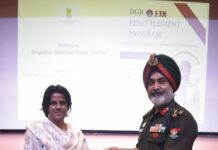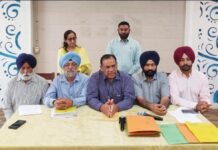Chief Secretary Reviews Rainwater Harvesting and Groundwater Recharge Action Plan in UT Chandigarh
In alignment with the Government of India’s “Jal Shakti Abhiyan: Catch the Rain 2025” campaign, themed “Jal Sanchay, Jan Bhagidari – Jan Jagrukta ki Or”, Sh. Rajeev Verma, Chief Secretary, UT Chandigarh, chaired a high-level meeting to assess progress and formulate a comprehensive action plan focused on rainwater harvesting and artificial recharge of groundwater.
During the meeting, several directives were issued to ensure timely implementation of water conservation initiatives. All government buildings, including schools, colleges, and Anganwadis, will be equipped with Rainwater Harvesting Structures (RWHS). A week-long cleanliness drive from May 1 to 7, 2025, will focus on maintaining existing RWHS across government institutions. Desilting operations at Sukhna Lake and check dams within the Sukhna Wildlife Sanctuary are scheduled to be completed before the onset of the monsoon. The Amrit Sarovar-Dhanas project is targeted to be completed by November 2025.
Further, in compliance with the JSA Mission, a target of planting 500,000 saplings has been assigned to the Forest Department, Engineering Department, and Municipal Corporation Chandigarh.
The meeting also emphasized the involvement of women Self-Help Groups (SHGs) in pond cleaning and community participation. “Jaldoots” will be appointed in schools and colleges to promote water conservation, with the Education Department tasked with submitting an action report. Further, regular consultations will be held with Resident Welfare Associations (RWAs) and Market Welfare Associations (MWAs) to raise awareness and drive collective action.
An advisory has been issued to Central, Haryana and Punjab government offices and complexes of autonomous bodies located in Chandigarh to establish RWHS on their premises. Standard Operating Procedures (SOPs) for Jal Shakti Kendra will be developed to strengthen educational outreach, complemented by mass media campaigns using jingles, advertisements, and pamphlets to spread awareness. Departments have been instructed to ensure timely uploading of data on the JSA portal for monitoring progress. Additionally, the Central Ground Water Board (CGWB) and the National Institute of Urban Affairs (NIUA) will conduct a detailed study of the shallow aquifer system in the region. Pre-monsoon desilting of road gullies and manholes will also be carried out to mitigate the risk of urban flooding.
Chief Secretary UT Chandigarh, Sh. Rajeev Verma, underscored the importance of meeting all deadlines and urged departments to execute their tasks with efficiency and accountability. He emphasized that the decisions and strategies discussed in the meeting would form the bedrock of future policies and sustainable water management practices in UT Chandigarh.
Present during the meeting were Sh. Mandip Singh Brar, Home Secretary, Sh. Amit Kumar, Commissioner MC Chandigarh, Sh. Nishant Kumar Yadav, Deputy Commissioner, Sh. Anup Kumar Soni, Deputy Conservator of Forests, UT Chandigarh and other officials of Chandigarh Administration and Municipal Corporation.











